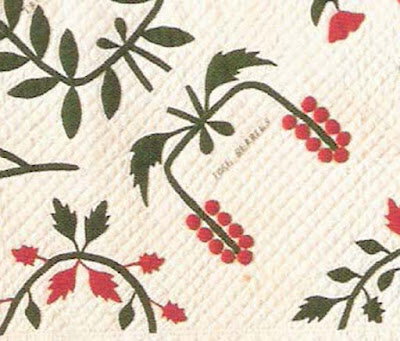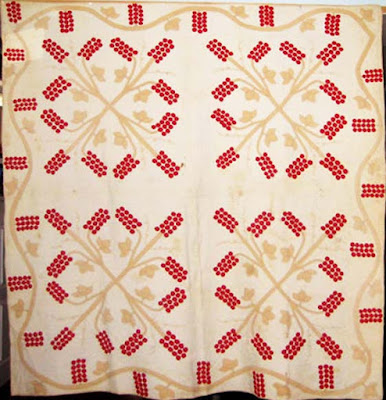There's little doubt what that large plant is.
Poke Weed
The quilt was made by Elizabeth Currier Foster whose family called it Poke Stalk.
From the Oregon Project and the Quilt Index
Block from a sampler in the collection of the Shelburne Museum
"Poke Berries" it says.
Phytolacca
It's a hardy American weed.
The bluish-black berries grow on a red stem. They make a fast natural dye and although the plant is poisonous people have been using it for herbal medicine for generations.
An 1818 botanical painting from Barton's Vegetable Material Medica
showing the poke berry, the flower and the leaf.
The leaf is simple.
From an online auction, made in Tennessee.
From Joyce Gross's collection at University of Texas, Briscoe Center.
From a sampler, no dots.
Next to an eagle
Colonial Williamsburg has 2 applique samplers with pokeweed blocks.
This one dated 1844 to 1847 was made for
Reverend & Mrs. William George Eggleston.
The block with the pokeberries is signed E. R. Moore, Ellicotts Mills (Maryland)
Quilt inscribed "To Emma"
1985.609.5
The other has four eagle blocks with the words E Pluribus Unum above each eagle
and the Lord's Prayer in the center.
See more about the two quilts at these links:
There may be more than just a desire to applique a lot of dots in these mid-19th century examples. Pokeweed had political symbolism in the 1844 Presidential election in which Democrat James K. Polk beat Whig Henry Clay.
Polk's Dream, a cartoon from the election.
In the lower right a potted POKE plant
But not what a pokeweed plant looks like.
"A thousand thanks to thee, good Mr. Chase,Apparently Polk partisans wore garlands of the berries (a messy concept.) There are stories that Polk supporters wore a branch on their lapels (another laundry problem) and that pro-Polk drovers stained their oxen with the berries, while Clay supporters rubbed clay on their oxen's horns.
This poke-weed garland on my brow I'll place.
If I this moment Mr. Polk could see
Quickly an office I'd obtain for thee. "
Hand painted political banner for the Whig candidates depicting
coons, the Whig symbol raccoons, eating poke berries.
The Whig banner was sold at Heritage Americana in 2005.
During the election Mississippi politician Jefferson Davis wrote about being berated by a "Whig lady [who] gave me quite a political lecture warning me against the stain of poke berries," a slightly oblique reference to the Democratic candidate.
I have seen discussion that this common design known variously as Poinsettia or Coxcombs & Currants is also a Poke Berry design favoring Polk. The pattern, however, seems to date from the 1850s. Below are two early date-inscribed examples.
Quilt dated 1852 by __ Dixon, Indiana Project & the Quilt Index
Quilt dated 1853 by Elizabeth Stark Whitlow, Ohio or Indiana.
Collection of the Kansas Museum of History.
Quilt for Reverend Dix, western Virginia,
West Virginia project & the Quilt Index
Many of the applique blocks that look like poke berries do not have poke's simple leaves. The branch above might be a bunch of grapes, except grapes don't really grown like that in single file along the stems.
Grapes from Johann Weinmann's 1745 illustration
From Cowhollow Antiques
Grapes are such an important classical image that many
of these botanical blocks may indeed depict grapes
as in this border from a feathered star quilt found in the Indiana project.
Botanizing
From an online auction




























